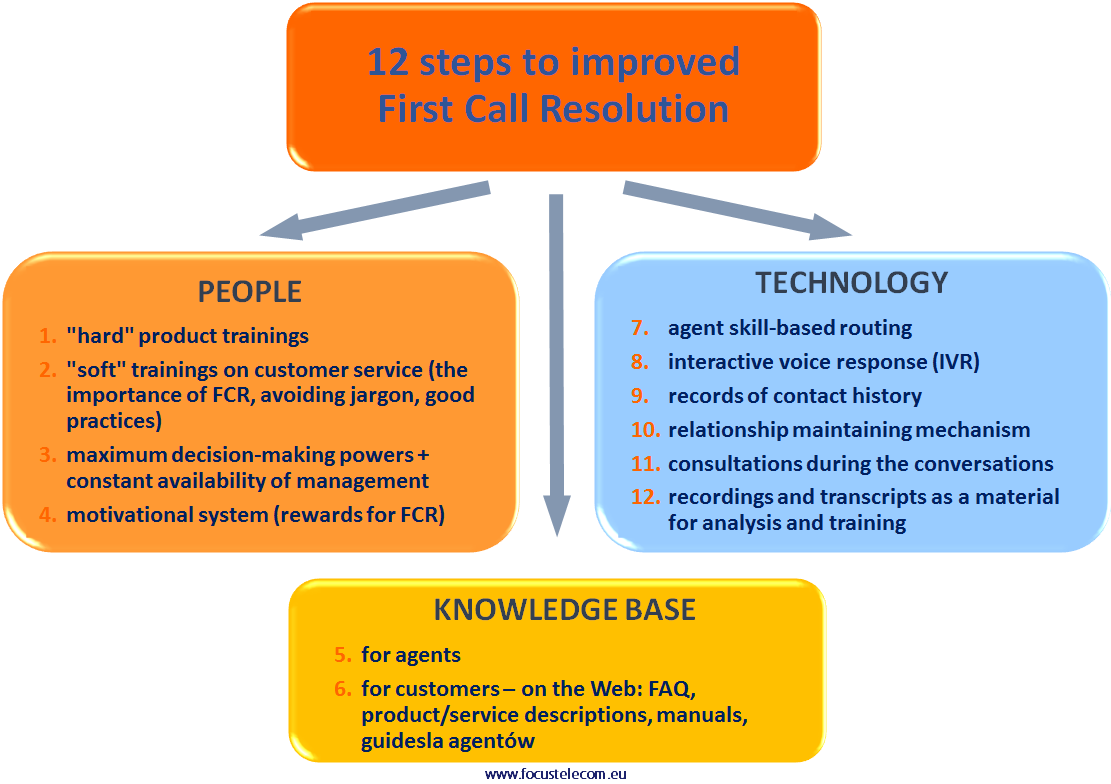
The percentage of First Call Resolution, i.e. customer-reported issues that were dealt with during the first contact with a consultant, is one of the most important indicators of a call/contact centre. Its importance in the evaluation of the quality of work is not subject to discussion, the achievement of a high level of this measure requires many coordinated actions. Below are our tips to raise the level of FCR in your company.
The importance of First Call Resolution:
Why is solving issues immediately so important? Here are three key reasons:
- higher satisfaction, and therefore loyalty, of the customer – a basic matter
- savings – reduction of working time and telecommunications expenditure on further contact about the same case.
- improved well-being, higher motivation and lower rotation of agents – derivatives of customer satisfaction. The rate of professional burnout among agents is highly dependent on the ability to meet customer expectations in everyday contact.
Despite the fairly universal awareness of the importance of speedy resolution of customer issues, measuring effectiveness in this regard is quite troublesome. Just like setting objectives. They vary depending on the industry, the type of goods and services, as well as several other factors. We will take on this issue in one of the following entries, whereas today we will discuss the most effective means of increasing First Call Resolution (FCR).
People – training and work organisation
1)”Hard” trainings on the procedures for the implementation of submissions/products/service – not only for newbies, but also periodically repeated trainings for experienced agents, along with tests for assessing knowledge
2) “Soft” trainings on customer service:
a) raising awareness on the importance of FCR,
b) learning to adapt the language used to the customer’s knowledge (in order to avoid using company and technical jargon),
c) the analysis of specific cases of customer service in the company, and encouraging the exchange of knowledge between agents.
3) Permissions – providing agents with the maximum allowed permissions in terms of solving reported problems is a necessary condition for raising FCR level. Another issue is the constant availability of managers for consultation, who can make decisions in more complicated cases.
4) Motivational system – should be linked to the achieved FCR level. Depending on customer service objectives, you must specify an appropriate balance between the desired level of FCR and productivity. In other words, you need to establish and clearly communicate to agents, whether the priority lies in the quality of service or its speed. In the first case, you should stop rewarding high levels of performance indicators (such as AHT, Average Handling Time).
Knowledge base
- For agents: a comprehensive and constantly updated directory with simple hints for resolving the most common customer issues, with information about the proceedings in more complicated situations, as well as contact information to experts/managers.
- For customers: posting on the company website the descriptions of products/services, manuals, guides, frequently asked questions – materials that tend to reduce the number of queries to the customer service department and may provide a point of reference during a discussion with an agent.
Technologies – useful features of communication tools
- Skills-based routing – a feature, which directs the customer to consultants specialising in a given subject. This allows to avoid situations in which the client presents his problem only to learn that they have wasted time, as they are redirected to another person, who is better acquainted with a given field, and reiterate the problem once more (or even worse – the customer is asked to call another number or/and at a different hour).
Using this feature is possible in case of customers who are already in the company database and it is known what kind of support, and in which area, they may need. They are assigned with tags associated with the purchased products/services, communication language (e.g. Polish, English), geographical location, or any other criteria. Similarly, tags are assigned to agents according to their competence, divisions (e.g. support, shipping, accounting, etc.), knowledge of foreign languages, geographical location or any other identifiers. An incoming client connection (by phone, e-mail, chat) is directed to a group of agent with the same tag (e.g. specialising in a particular product and/or English-speaking), which significantly increases the chances of providing a quick solution to the customer’s problem. Feature present in more advanced communication platforms (such as Focus Contact Center).
- Interactive Voice Response – the customer, after calling the company, selects the division they want to contact on their own. The redirection takes place after listening to a message and selecting one of the numbers associated with a given department. Contact with a specific department increases the chances that the customer will submit their problem to a person who is appropriately competent to solve it. IVR can be used in combination with skill-based routing.
- Contact history – connecting the communications platform with a database, which collects information about the entire history of contacts with each customer (CRM). A very useful feature in customer service, as solving a reported problem often requires information about the model purchased by the client, repairs history, distributor, needs and possibilities of the client (e.g. in the clothing industry – customer’s measurements, in the software industry – the hardware or OS), and often the client alone is not able to provide this information.
- Maintaining relation – a mechanism that allows to redirect a client’s connection (phone call, e-mail, chat) to the agent, who spoke to the customer last time. In this way, the agent is already aware of the situation, which allows them to quickly solve the customer’s problem.
- Consultations (phone contacts) – if a consultant does not know how to solve the client’s problem, they can ask to wait without hanging up and get advice from other, more experienced consultant or manager. The client hears music or other selected content, rather than the conversation. Clients do not like to wait, but usually they prefer this solution than having to contact customer service again.
- Conversation recordings, chat transcripts, e-mail log – along with features facilitating listening and viewing their selected fragments. A regular analysis of recorded calls with customers allows you to capture common mistakes made in communication, indicate, and then fix them, along with pointing out model patterns, as well as anti-patterns, which provide excellent material for training. Online evaluation forms with predefined assessment criteria are very helpful in analysing many recordings (available on the Focus Contact Center platform).
Do you have any questions? Do you want to know more about customer service? Ask our experts.






